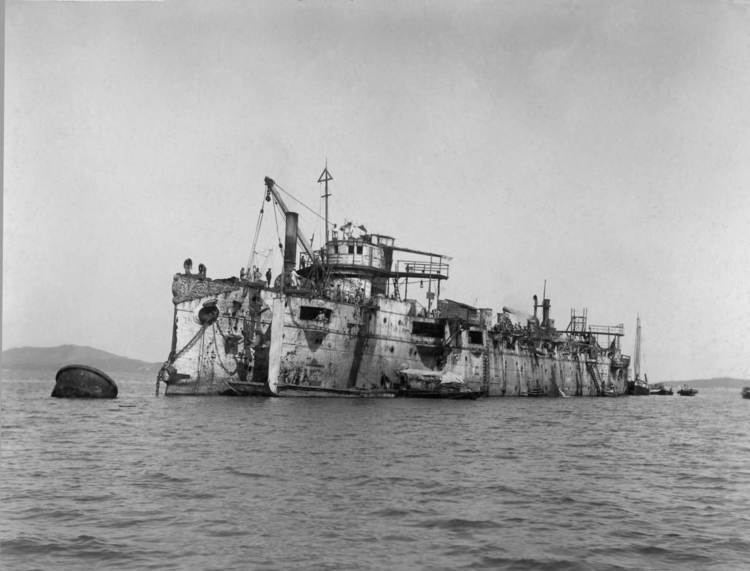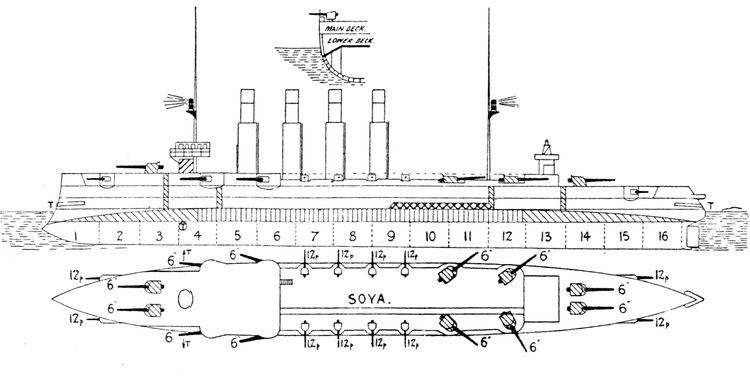Name Varyag Launched 31 October 1899 Beam 15 m Commissioned 2 January 1901 | Laid down October 1898 Construction started October 1898 Length 130 m Builder William Cramp & Sons | |
 | ||
Fate Scuttled 9 February 1904 Fate Returned to Russia, 5 April 1916 | ||
Russian cruiser varyag 1899
Varyag (also spelled Variag; see Varangian for the meaning of the name) (Russian: кре́йсер «Варя́г») was a Russian protected cruiser. Varyag became famous for her crew's stoicism at the Battle of Chemulpo Bay.
Contents
History

The Imperial Admiralty contracted William Cramp and Sons of Philadelphia to build the ship, and her keel was laid in October 1898. Launched on 31 October 1899, under Captain Vladimir Behr, she was commissioned into the Imperial Russian Navy on 2 January 1901.

During her construction, an assistant physician, Leo Alexandroff, left the ship's advance party on 20 April 1899, and applied for U.S. citizenship. He was arrested for desertion. His case reached the United States Supreme Court, which ruled in Tucker v. Alexandroff that the ship, though not accepted for service in the Imperial Russian Navy, was a warship under the terms of the 1832 treaty between Russia and the United States.

During the Battle of Chemulpo Bay at the start of the Russo-Japanese War, Varyag (under the command of Captain of the First Rank Vsevolod Rudnev) accepted a badly unequal battle with the Japanese squadron of Admiral Uriu (one armoured cruiser, five protected cruisers and eight destroyers) in a heroic attempt to break out from Chemulpo (Incheon) harbour 9 February 1904. Chemulpo was in neutral Korean waters. Admiral Uriu gave the Russian ships in harbor a written ultimatum to sail by 12:00 noon or be attacked in the harbor itself. Captain Rudnev sortied, accompanied by the gunboat Koreets; having lost 31 men dead, 191 injured (out of 570) and outgunned, both ships returned to harbor by 1:00 p.m., the crew decided not to surrender, but to sink the ship. The crew was saved by transferring them to the British cruiser Talbot, the French cruiser Pascal, and the Italian cruiser Elba; the captain of the US gunboat Vicksburg declined doing so as a violation of U.S. neutrality.

In 1907, Vsevolod Rudnev (by that time dismissed from Russian naval service in the rank of rear admiral) was decorated with the Japanese Order of the Rising Sun for his heroism in that battle; although he accepted the order, he never wore it in public.
Varyag was later salvaged by the Japanese and repaired. She served with the Imperial Japanese Navy as light cruiser Soya.
During World War I, Russia and Japan were allies and several ships were transferred by the Japanese to the Russians. She was repurchased by the Imperial Russian Navy at Vladivostok on 5 April 1916 and renamed back to Varyag. In June, she departed for Murmansk via the Indian Ocean, arriving in November 1916. She was sent to Liverpool in Great Britain for an overhaul by Cammell Laird in February 1917, and was due to re-enter service with the Arctic squadron of the Russian Navy. However, following the Russian October Revolution on 7 November 1917 crewmen who had remained onboard hoisted the red flag and refused to set sail. On 8 December 1917 she was seized by a detachment of British soldiers. Assigned to the Royal Navy in February 1918, she ran aground while under tow off of Ireland, but was refloated and used as a hulk until 1919. She was then sold to a German firm in 1920 for scrap, but ran aground on rocks near the Scottish village of Lendalfoot (55°11′03″N 04°56′30″W) in the Firth of Clyde, while being towed to Germany. She was scrapped in place from 1923-1925.
Legacy
The stoicism of Varyag's crew at Chemulpo has inspired the Austrian poet Rudolf Greinz to write a poem dedicated to Varyag. The Russian translation of this poem was put on music by A.S. Turischev. The result was the 1904 song that remains popular today:
(German original)
Auf Deck, Kameraden, all' auf Deck!
Heraus zur letzten Parade!
Der stolze Warjag ergibt sich nicht,
Wir brauchen keine Gnade!
Rudolf Greinz
(Russian poetic translation)
Наверх вы, товарищи, все по местам!
Последний парад наступает.
Врагу не сдается наш гордый “Варяг”,
Пощады никто не желает.
(translation)
Get up you comrades, take your places,
The final parade is at hand.
Proud "Varyag" will not surrender to the enemy,
No one wants their mercy.
On Sunday 30 July 2006 (Russian Navy Day), a monument to the cruiser was unveiled at Lendalfoot in a ceremony attended by senior Russian politicians and navy personnel, veterans and local dignitaries.
On 8 September 2007 a large bronze memorial was dedicated at Lendalfoot.
In 2010, as a gesture marking the 20th anniversary of diplomatic relations between Korea and Russia, the flag of Varyag was restored. The Japanese Navy recovered the flag when the ship was salvaged; and the Incheon Metropolitan Museum acquired them after Japan's defeat at the end of World War II. The return of the flag takes the form of a two-year renewable loan because of the Korean law protecting cultural assets.
